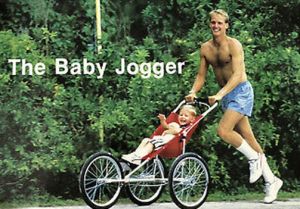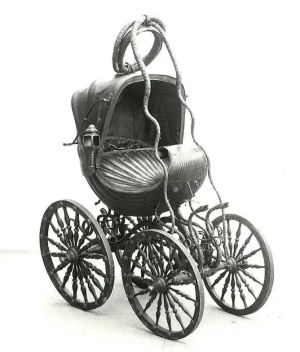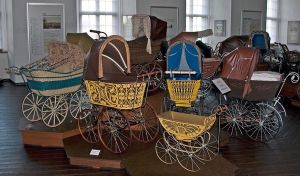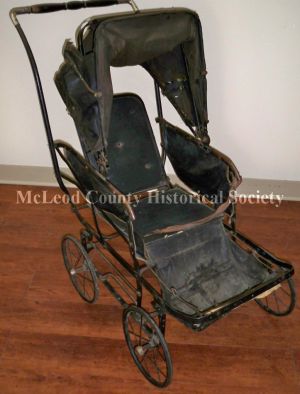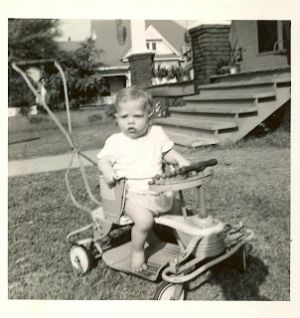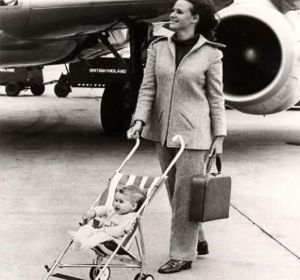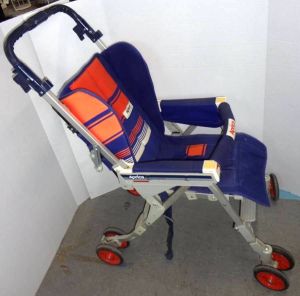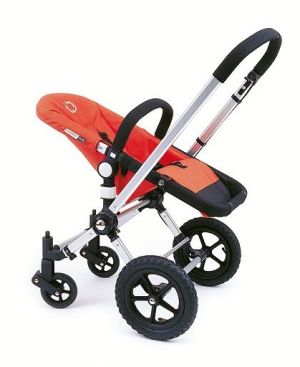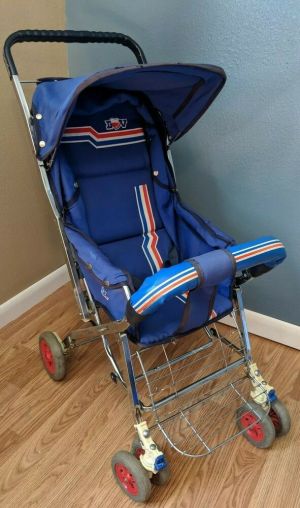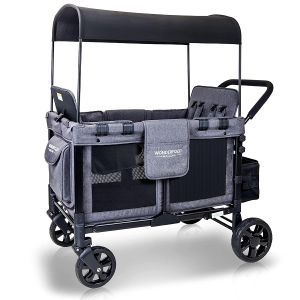Main Page: Difference between revisions
| Line 167: | Line 167: | ||
Fellow Kiwi stroller maker Phil & Teds added to the all-terrain craze with an “in-line buggy” that could transport two kids. | Fellow Kiwi stroller maker Phil & Teds added to the all-terrain craze with an “in-line buggy” that could transport two kids. | ||
All-terrain stroller remain an important category today with models by BOB Gear and Thule commonly seen on hiking trails. | |||
== The Dudes Arrive: Daddy Designers == | == The Dudes Arrive: Daddy Designers == | ||
Revision as of 17:33, 21 August 2023
Welcome to StrollerWiki—the Wikipedia site for baby strollers!
This site provides detailed info on major baby stroller makers (more to come):
- BABYZEN
- BOB
- Baby Jogger
- Baby Trend
- Bombi
- Britax
- Bugaboo
- Century
- Chicco
- Cosco
- Cybex
- Delta Children
- Diono
- Doona
- Evenflo
- Gb
- Graco
- Joolz
- Joovy
- Keenz
- Kolcraft
- Larktale
- Maxi Cosi
- Mockingbird
- Mompush
- Mountain Buggy
- Nuna
- Peg Perego
- Phil & Teds
- Safety1st
- Summer Infant
- Thule
- UPPAbaby
- Veer
- Wonderfold
| Did you know . . . |
|
|---|
A Brief History of the Baby Stroller
Architect William Kent is widely considered the father of the modern baby stroller, designing a carriage for the Duke of Devonshire in 1733. But was this really the first baby stroller?
Before the modern era
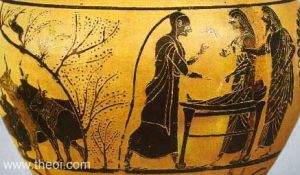
There are a few references to conveyances used to carry babies and children earlier than 1733. A 520 BCE Etruscan vase depicting Hermes stealing Apollo’s cattle is said to portrays Hermes as a baby in a wheeled conveyance—although this looks more like a wheeled cradle than a stroller.[2]
Along that same vein, a Japanese painting from the 14th century also shows a Chinese baby in a carriage with wheels pulled by a rope.[3]
Oddly, beyond this vase and painting there are no references to wheeled baby carriages in ancient historical documents—most babies were carried during this part of history.
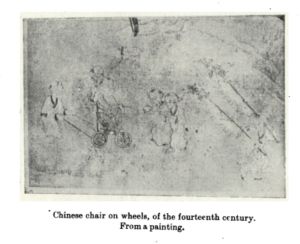
Wheeled toys have been found in Egypt, Rome and Greece as well as India, Ceylon (now Sri Lanka) and even Meso-America. This has lead some to believe that wheeled carriages and carts were also common. However, it wasn’t until improvements in roads and pavement that chariots, wheeled carriages and large wagons were used broadly. In England, enclosed carriages for passengers were first introduced in 1555.[5]
That’s not to say parents didn’t adapt carts and small wagons to multiple uses including carrying children. An example are the hop wagons in Kent in the UK, which were imported from Europe in the 16th century.[6]
The First Royal Baby Carriage: William Kent's Stroller For the Duke Of Devonshire, 1733
A watershed moment in baby strollers came in 1733. A landscape architect working for the Duke of Devonshire, William Kent, designed the first baby stroller as a way to “amuse his (the Duke's) children in transit.”
Designed to be pulled by ponies, dogs or goats, the Duke of Devonshire’s Chatsworth Serpent Pram was named for snakes that adorned the carriage (the Duke of Devonshire’s crest includes snakes). Given the extravagant cost of the carriage, this one-off creation didn't actually spur an industry of baby buggies.
It would take another century—and the rise of the Industrial Revolution and the middle class—before strollers would become standard parenting equipment.
Fast forward to the 1830’s when the first craftsmen began building and selling baby carriages. The Industrial Revolution and world-wide trade made it possible to build quantities of baby carriages. Benjamin Potter Crandall and his son Jesse marketed the first baby carriages in the US in the 1830’s. Jesse later invented several improvements including a brake and parasol.[7]
At the same time, the US market for baby carriage makers was booming. Many of these companies were located in Massachusetts. In Greenfield, MA, J.P. Prentice built his first baby carriage for his daughter, who was born in 1835. Greenfield later became known as a center of baby carriage manufacturing as fellow stroller makers Henry Warner, J. Morris Munson and Frank and Samuel Boylston set up shop in the area.
Meanwhile in Europe, the Germans began making carriage strollers in Zeitz, Germany in 1846 when Albert Naether founded his workshop. It later grew into one of Europe’s largest maker of baby carriages and prams, the Naether Stroller Factory.[8]
The First Pushed Baby Strollers: mid 1800's
Prior to 1848, all baby carriages were pulled by pony, dog or goat. Charles Burton, an American inventor, designed the first baby stroller that could be pushed by an adult. He took his design to London in 1848, where he successfully introduced it to the British. He adopted an existing expression for “walking about” to name his stroller—perambulator, later shortening the term to pram.[9]
The word “perambulator” dates back to the 1560’s:
“walk through, about, or over," 1560s, from Latin perambulatus, past participle of perambulare "to walk through, go through, ramble through," from per "through" (from PIE root *per- (1) "forward," hence "through") + ambulare "to walk, go about" (see amble (v.)). Related: Perambulated; perambulating.[10]
Changes in parenting styles (and the expansion of the middle class in England) also factored into the rise of the stroller.
Instead of keeping children at home, popular English pastimes like Sunday promenades for health and social interaction promoted introducing children to the outside world sooner. The baby carriage made that interaction much easier for stylish young parents.
The British became leaders in pram production in the late 1800’s. You can find numerous examples of British prams at historical museums with their very high wheels, steel frames, suspensions, bassinette-style wicker baskets, leather hoods and brakes. Seat belts were patented for baby carriages in 1884.[11]
In 1888, African American inventor William H. Richardson patented the first reversible carriage basket and in 1894 the British patented a reversible handle.[12]
Early 20th Century: The First Folding Baby Stroller.
The first patent for a folding baby stroller in the US was issued in 1904. The Allwin was made by the Sidway Mercantile Company in Elkhart, IN. They were also called the “Go-cart from Elkhart.”[13]
The numerous innovations and patents for baby strollers in the early 20th century brought out a boom in stroller makers.
By the 1920’s, Britain boasted over 200 pram makers—with an estimate three million strollers in use by 1923.[14] Wheels in the 20’s and 30’s got smaller and the first pushchair, ancestor of the modern stroller, first appeared. Pushchairs were not as popular as prams, however.
Meanwhile, in the US, several famous baby carriage makes continue to prosper.
F.A. Whitney Carriage Co. was founded in Leominster, MA in 1858 and patented a reversible handle in 1876.
Up until 1881, the company made the baby carriage bodies out of wood. In 1881, F.A. Whitney began experimenting with wicker (made of willow). Later in 1904, the company began making paper wicker (“twisted paper pregnated with glue sizing”), which they patented. The paper lasted longer (if taken care of) than the willow reed wicker, which dried out and cracked.[15]
Many of US baby carriage makers didn’t survive the Great Depression and rationing of materials during World War II. F.A. Whitney closed its doors in 1952.
Baby Boom: Post War Surge in Baby Gear
Imagine adding 4.24 million babies to the US population every year. That actually happened between 1946 and 1964.[16] With that many babies born each year (and that’s just an average per year; some years had more), it’s no surprise that baby products from cradles to high chairs to strollers also surged in demand during that period. Immediately after the war, carriages (where babies lied flat) continued to be popular, but by the 1950’s to 1960’s, stroller with seats started to make inroads with young parents.[17]
Why? Americans moved to the suburbs, had more leisure time and had more money to spend.
The suburbs had miles of paved sidewalks and streets—and the stroller boom took off.
Unlike the bulky prams of the 1930’s and 40’s, new strollers were smaller and more compact. A good example was the Taylor Tot, made by the Frank Taylor Company of Cincinnati, OH.
This stroller featured a metal chair, frame and wheels—more like a tricycle with a push handle than a modern stroller.
Meanwhile, companies that made gear for babies continued to grow. The post World War II baby boom gave rise to baby gear companies like Evenflo (which started as a bottle maker) and Graco, which launched in 1957 with a swing. Success in one category often led companies like Graco expand into other baby products.
Rise of the Imports: British Invasion
The quest to make baby strollers lighter and more portable got a major boast in the 1960's.
In 1965, British engineer Owen Maclaren, a former test pilot, designed the first “umbrella” stroller—it was designed to fold into a compact design similar to an umbrella. Another crucial feature: the Maclaren stroller was made of made of lightweight, aircraft-quality aluminum. That was a first, as most strollers sold at the time were still made of steel.
Maclaren imagined his new stroller would allow parents to travel the world more easily.[18]
On the heels of the British invasion, the Italians came to the US as well in the 60’s—Italian stroller maker Peg Perego set up shop in Fort Wayne, Indiana to be close to their largest customer, Sears. The company first marketed ornate prams or carriage strollers. These featured fine Italian fabrics and detailing and sold for premium prices.
Another popular European stroller maker that made a splash in the US was Sweden's Emmaljunga. This company started in 1925 and saw its heyday in North America with a line of expensive prams in the 1960's and 70's.
Birth of Baby Gear Companies
The post-World War II economy saw another development that impacted the stroller market: the birth of baby gear companies.
Unlike companies that specialized in one product, these corporations expanded into a myriad of baby gear categories. Among the earliest was Evenflo, which started in 1920 as the Pyramid Rubber Specialty Company in Ravenna, Ohio making rubber baby bottle nipples. By pairing the nipples with glass bottles made by nearby glass manufacturers in Pittsburgh, the Evenflo baby bottle was born. Soon Evenflo expanded into other categories like nursery furniture and strollers.
In 1955, Graco introduced the first wind-up swing—and soon expanded into other baby product like strollers by the 1970’s.
Another early pioneer of modern strollers was Century, which got its start in 1961 with the launch of a baby seat/carrier called the TotToter. This eventually morphed into the first infant car seat with a stay-in-the-car base, launched in 1986.
Century then paired this infant car seat with a stroller to create the first travel system in the early 1990’s.
Rise of the Imports: Japan
Along with the European stroller makers, the 1980’s saw the rise of another successful stroller exporter: Japan.
The two biggest Japanese stroller makers, Aprica and Combi, were popular in the 1980’s for their high-end, lightweight strollers. By 1985, Aprica was selling 200,000 strollers a year in the US. These premium strollers sold for $200 in 1985 or about $545 in today’s dollars.[19]
The Japanese strollers took the Maclaren umbrella stroller and replaced the two handles with a single handle that could collapse. Made of lightweight aluminum, these strollers weighed as little as 7.7 lbs.
Ultimately, US stroller companies figured out a way to make lightweight strollers at lower price and the Japanese strollers declined in popularity in the 2000’s.
The Jogging Stroller
Sometimes fitness crazes translated into stroller advancements. Case in point: jogging.
Even though the jogging craze got its start in the 1960’s, it really took off the 1970’s. Runner Phil Baechler wanted to take his baby with him on runs, so he thought of marrying air-filled bicycle tires with a stroller with a sling-style seat. The Baby Jogger was born in 1984.
Jogging strollers reached their peak of popularity in the 1990's. Baby Jogger, however, ran into financial difficulty in the early 2000's and declared bankruptcy. Baby Jogger was bought out of bankruptcy in 2003 by Dynamic Brands, which also owned several companies that made golf bags and accessories.
The company was revived and later sold to Graco's owner (Newell Brands) in 2014.
Rise of the Imports: New Zealand and the All-Terrain Stroller
New Zealand engineer Alan Croad saw a picture of the Baby Jogger in a parenting magazine and thought about adapting it for outdoor adventures in New Zealand. He swapped the large tires with smaller wheels and (eventually) a turnable front wheel. The all-terrain, tri-wheel stroller named the Mountain Buggy Jungle debuted in 1992.
Fellow Kiwi stroller maker Phil & Teds added to the all-terrain craze with an “in-line buggy” that could transport two kids.
All-terrain stroller remain an important category today with models by BOB Gear and Thule commonly seen on hiking trails.
The Dudes Arrive: Daddy Designers
The rise of industrial designers and daddy bloggers brought another new type of stroller in the early 200’s: the Dude Stroller.
Designer Max Barenburg conceived a stroller as part of a college design project that eventually became the Bugaboo. Unlike other strollers on the market at the time, the Bugaboo was intended as a luxury purchase for urban parents, including dads frustrated with too-short stroller handles (the Bugaboo had a height-adjustable handle).
The Bugaboo was a modular stroller with bassinet and stroller seat that could be interchanged on a stroller frame.
About the same time in Germany, designer Martin Pos launched Cybex to “marry design and technology in one.”
The success of the first Bugaboo (the Frog) brought a host of knock-offs, including UPPAbaby. Their main innovation was the addition of a second seat—making the single-to-double stroller a category of its own.
With moms waiting till later in life to have babies, the turn of the century also saw a new trend called age compression: having children closer in age than before. To address this, modular strollers like the UPPAbaby Vista entered the market. One stroller that could expand to accommodate a second baby was a hit.
Rise of Imports: China.
The rapid growth of Chinese-made baby strollers has its roots in the 1980’s. Among the first US hits was the Delta Luvy Buggy, one of the first metal strollers that could quickly fold.
By the 2010’s, China became the number one source for the manufacture of baby strollers. Goodbaby (among others) dominated the manufacture of strollers and later decided to market their own strollers to consumers.
Goodbaby started out as a manufacturer for other brands before purchasing the Evenflo and Cybex brands to have more control over the supply chain.
2020’s craze: Stroller Wagon
By the 2010’s and 2020’s, a hybrid of strollers and wagons gained popularity. First debuting with Keenz and WONDERFOLD, the stroller wagon could hold up to four kids but still could be pushed or pulled with a handle.
Storage is a big plus with stroller wagons allowing parents to pack enough snacks and accessories to get through excursions to the zoo, the beach and more.
- ↑ https://babel.hathitrust.org/cgi/pt?id=njp.32101068130804&seq=15
- ↑ https://babel.hathitrust.org/cgi/pt?id=njp.32101068130804&seq=15
- ↑ https://www.jstor.org/stable/41356294
- ↑ https://www.jstor.org/stable/41356294
- ↑ https://www.britannica.com/technology/coach-horse-drawn-vehicle
- ↑ https://www.jstor.org/stable/41356294
- ↑ https://www.thoughtco.com/history-of-baby-carriages-4075936
- ↑ https://www.atlasobscura.com/places/deutsches-kinderwagenmuseum-german-stroller-museum
- ↑ https://www.thoughtco.com/history-of-baby-carriages-4075936
- ↑ https://www.etymonline.com/word/perambulate
- ↑ https://www.atlasobscura.com/places/deutsches-kinderwagenmuseum-german-stroller-museum
- ↑ https://patents.google.com/patent/US405600A/en
- ↑ https://mcleodhistory.pastperfectonline.com/webobject/2BAD2E47-9031-4E9A-9167-150378652989
- ↑ https://www.jstor.org/stable/d44d4702-7cc5-39e9-910f-06d0017ec3fc?seq=1
- ↑ https://babel.hathitrust.org/cgi/pt?id=njp.32101068130804&seq=1
- ↑ https://www.khanacademy.org/humanities/us-history/postwarera/postwar-era/a/the-baby-boom
- ↑ http://www.faqs.org/childhood/Pa-Re/Pram.html
- ↑ https://shop.maclarenbaby.com/history-heritage?ctr#:~:text=In%201965%20in%20rural%20England,baby%20wheeling%20around%20a%20bulky
- ↑ https://www.nytimes.com/1985/10/12/business/now-japan-s-stroller-invasion.html
